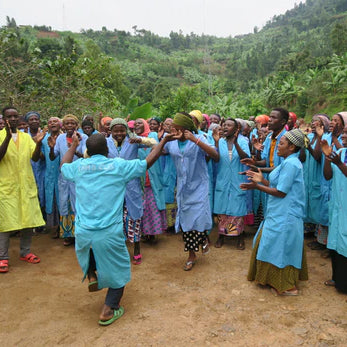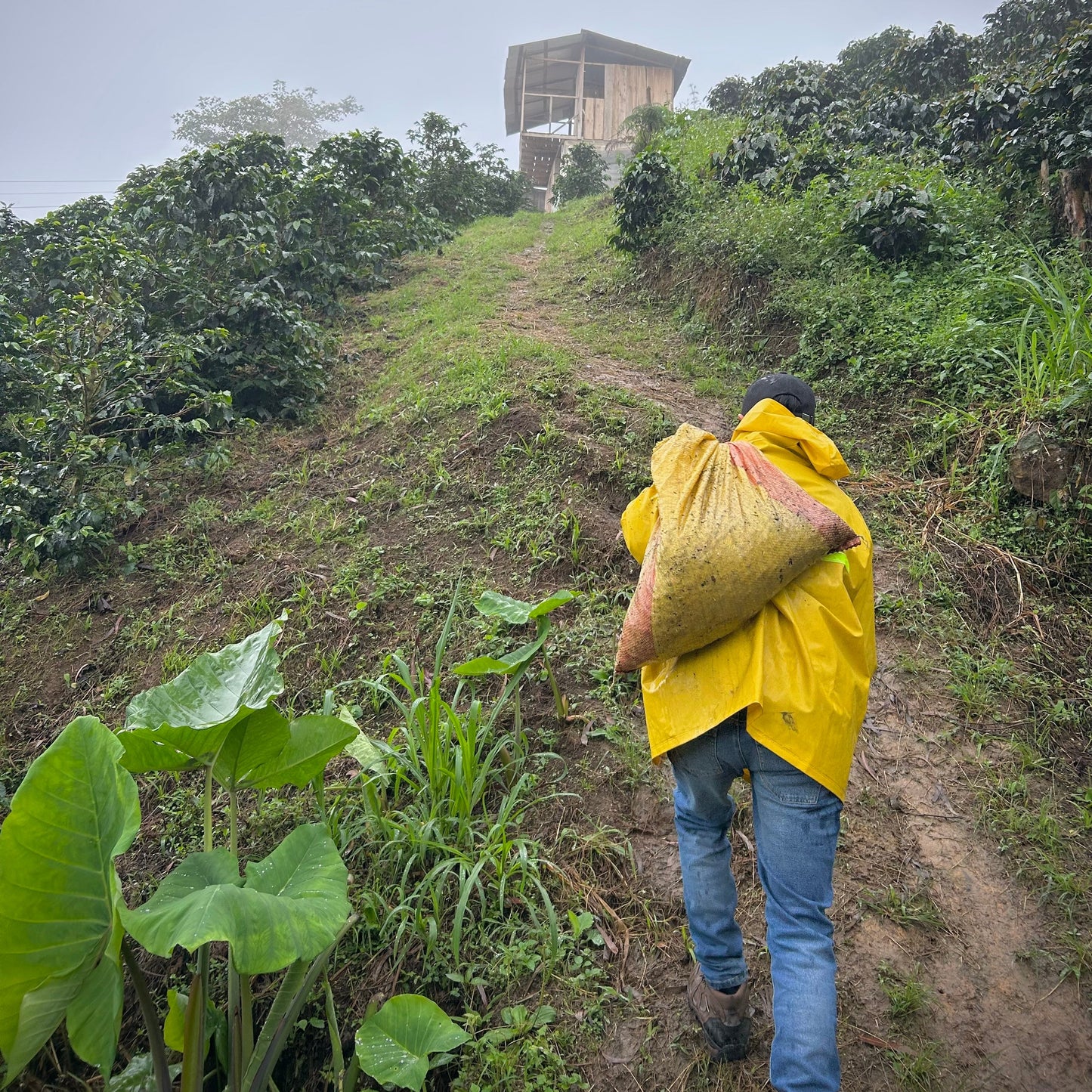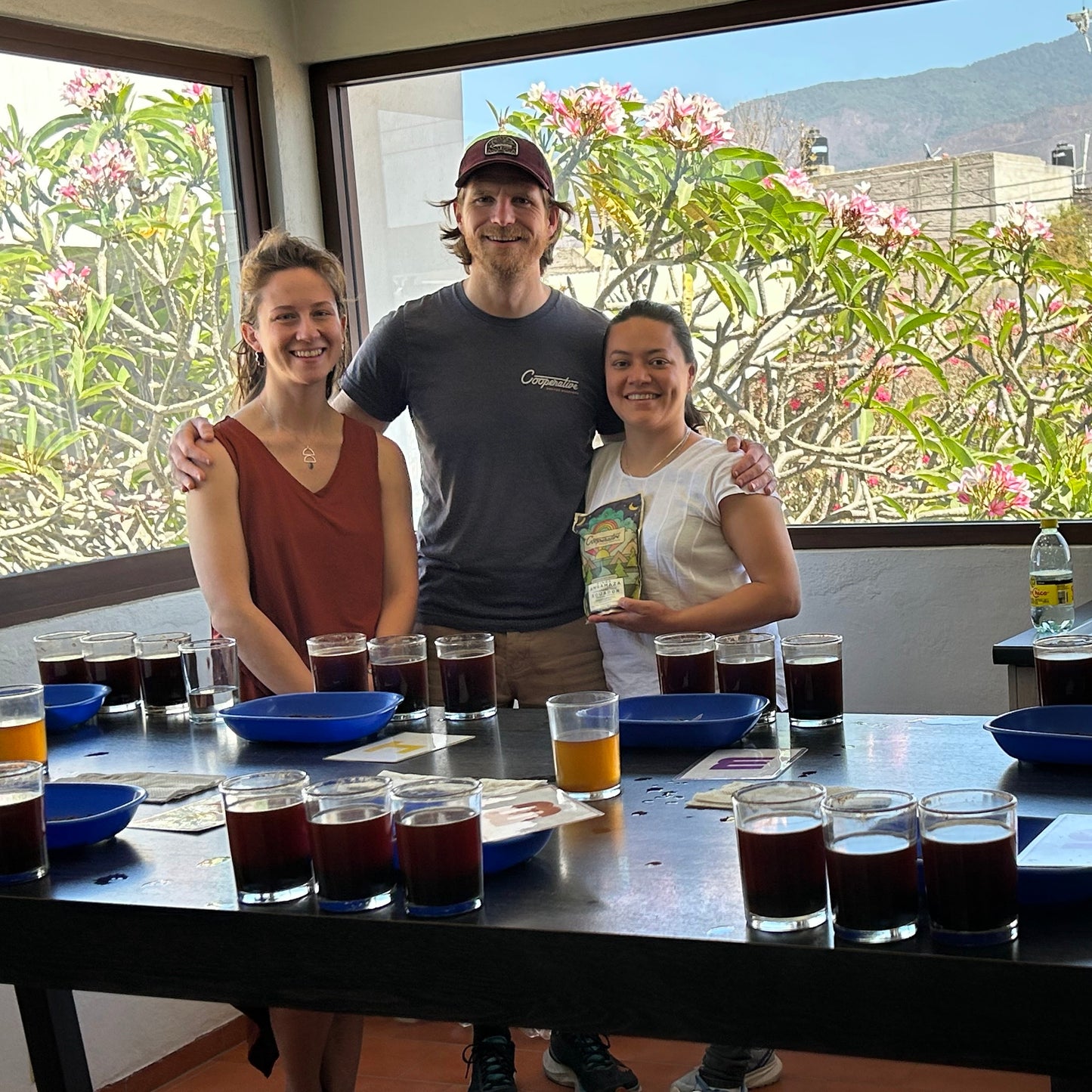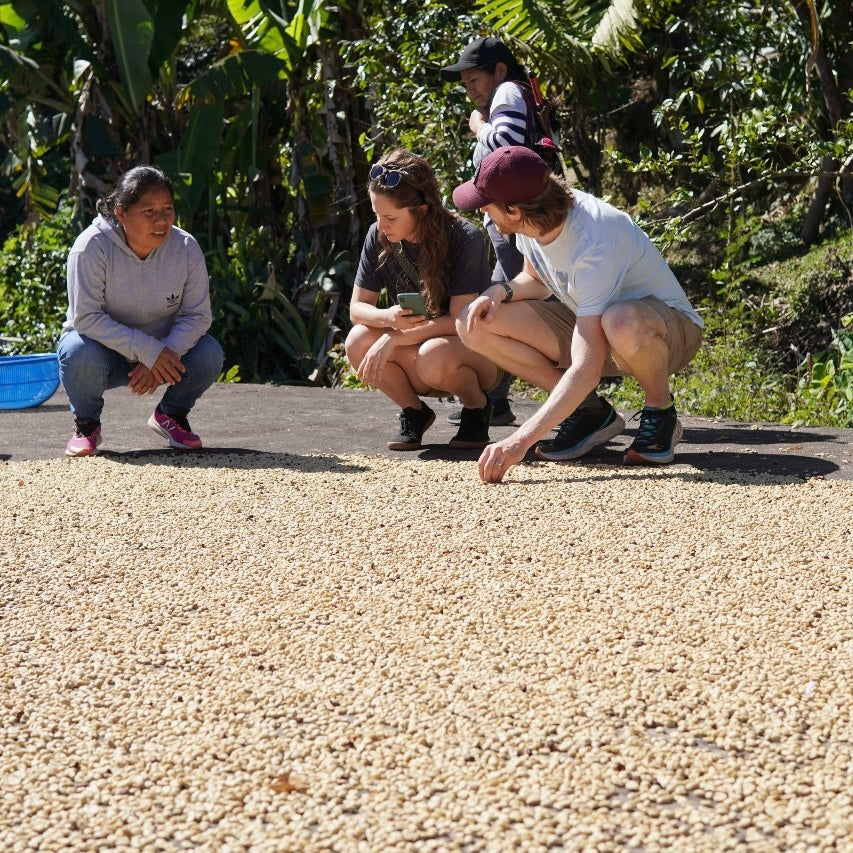

Coffee Harvest & Process
Producer: Bugoyi Islands Group - 27 smallholders
Processing Station: Bugoyi
Location: Kigeyo Sector, Rutsiro District, Western Province, Rwanda
Harvest: April - June
Station Owner: Baho Coffee / Emmanuel Rusatira
Exporter: Baho Coffee / Emmanuel Rusatira
Importer: Sundog Trading
Altitude of Farms: 1500 - 1900 masl
Average Farm Size Farm Size: 0.3 hectares
Average Age of Trees: 14.5 years old
Expected Volume Per Tree: 2.8 kg
2020 Average Total Harvest Volume: 1,463 kg
Price Transparency
● 2020 Rwanda national farmgate price - 216 rwf/kg
● 2020 Baho average farmgate price, paid at Bugoyi - 287 rwf/kg
● 2020 FOT Kigali price, paid to Baho Coffee for Bugoyi Islands lot - 3.27 usd/lb
Farmer First Premium Program
The 2020 season marks our first year directly contributing to second payments via the Farmer First Premium Program (FFPP). We increased our FOT price (paid to Baho Coffee) by 0.20 usd/kg above our initial established price for all coffees purchased. Emmanuel plans to isolate this money and disperse
additional payments to farmers later in the year. The Rwanda National Agricultural Export Board (NAEB) sets a nationally mandated farmgate price for cherry each year, with the goal of reducing predatory buying practices. This has undoubtedly increased wages for the majority of farmers across the country, but it hinders some station owners by also creating a price ceiling in an attempt to establish market parity. Emmanuel personally experienced crossing this line in 2018, when he received a letter from the government demanding that he lower prices or else be fined. We’ve learned over the past few years that getting more money into the hands of farmers isn’t quite as simple as raising prices at the station.
Baho has adopted a second payment system as a workaround to this issue. Giving farmers additional compensation later in the year means that you can go off the official books. Through the FFPP, we’re hoping to provide more consistency to the system by setting aside specific amounts of money each season to pay Baho’s producer partners more and more. The increased level of traceability that Baho has been able to achieve is making this process much easier, as we can now begin with specific small groups to implement the program.
We’re starting small for year one as we trial run the system, but we hope to scale everything up as we grow together in the future and continue to explore Rwandese farmers’ costs of living.
BUGOYI STATION
Bugoyi is located in the Western Province of Rwanda - near the border of the Democratic Republic of Congo and directly on the shores of Lake Kivu. This region generally receives very soft sunlight and cool winds coming off the lake, which Emmanuel praises as the driving force behind the particularly even drying at Bugoyi.
Built in 2012 and purchased by Baho in 2016, Buogyi is Emmanuel’s largest station producing predominantly specialty coffee. Bugoyi collects cherry from ~1300 farmers, producing ~1300 bags of exportable coffee annually, and employing 187 people at the peak of the season. On top of their standard wages, Baho pays into both health insurance and pension plans for all workers at Bugoyi. Along with Fugi, this is the first station that Emmanuel focused on when launching the Baho operations.
Average production volume on the small plots surrounding this station are quite low at only around 1.5 kg cherry per tree. This is mostly attributed to the extremely old trees in the area; many have been in production for close to 30 years. Emmanuel has been focusing heavily on growing Baho’s seedling distribution, and 16,000 were distributed to the Bugoyi farmers in 2019. Emmanuel has found that with his higher cherry prices, producers are becoming increasingly interested in investing in their coffee farms and growing future production.
BUGOYI ISLANDS
Emmanuel presented to us a handful of lots in 2019 that were traced back to communities surrounding specific hills. This initiative immediately sparked our interest and kickstarted our discussions on how we could expand and deepen this type of traceability. As buyers, it’s always exciting to find more information about where coffee is coming from; but additionally, Emmanuel made it very clear that it was helpful to Baho and their producer network as well. It created the opportunity to directly support producers and hopefully motivate them to continue in specialty.
The Bugoyi Islands are a set of 4 islands in Lake Kivu, nearest the Bugoyi station - Nyamirundi Island, Nyandima Island, Ntumba Island, and Nyarurwa island. In total, ~80 farmers have land here planted with various crops, and they deliver coffee to Bugoyi via small boats. People lived on the islands many years ago, but now the government has declared it a high risk zone for residential housing. Though the population has now moved onto the mainland, they still tend to their farms on the islands. Baho separated these farmers into smaller groups of 20-30 each; and thus, this specific lot is a compilation of coffee from 27 producers.
We’re incredibly excited about the amount of traceability that Baho was able to provide for the smaller lot separations this season. It’s the first big step in building a transparent and equitable relationship with groups of farmers that we hope will deliver to Bugoyi for many years to come.
In Emmaneul’s words:
We have more than 80 farmers from these islands that are active and happily work with Bugoyi coffee washing station (cws). Each morning, using boats, farmers sail in water and go to farm and come back at evening . They now use these islands to grow cassava, beans , banana as well as coffee. They also do fishing.
We choose to process coffee from these islands separately from others after we have identified that it is heavy (density), less of floaters, and hence - high potential for coffee quality. In general, the farmers using these islands are economically respected and considered to be one of the stable farmers in the area. Baho will keep working with them and will also continue to ensure full traceability of coffee from these islands and appreciate the good work done by the farmers . We will also seek for support and project that might financially, technically, and socially improve livelihoods.
Processing
The initial steps for each process are the same: First, a day of intensive sorting at the cherry stage, under complete shade, to ensure only the ripest are chosen and any visible defects are removed. Step two is multiple rounds of floating - filling a large container with cherries and water, discarding the less dense cherries that float to the top of the tank. The densest coffees (sinkers) are reserved to be processed as the higher grade lots, and the less dense coffees (floaters) are mixed in with the rejected cherries from the initial sorting to be processed as lower grade lots. It’s expected that cherries are delivered to stations, on average, between 2 to 3 hours from picking. The highest quality cherries are selected and placed into sealed bags overnight, ~12 hours in total.
The following morning, coffee cherries are spread out onto raised beds to begin the drying process. The goal is for cherries to be a single layer on the beds, maximum 2 - 4 cm of depth. Each station has calculated exactly what volume will fit perfectly on their sized tables to achieve this. For the first 5 days, the coffee is turned every hour. From day 5 to day 20, coffee is turned every 2 hours. From day 20 - 50, the coffee and ambient temperature are strictly monitored to keep the rate of drying slow and controlled. Temperature is recorded throughout the day - if it exceeds certain thresholds, workers will focus on turning coffee more frequently or cover the beds with mesh netting. In more rare cases, if the temperature exceeds extremely high thresholds, entire beds will sometimes be relocated under complete shade for a few days.
This focus on extremely thin layers, coupled with frequent turning and temperature monitoring, is to ensure that the flavors remain clean and free from over-fermentation or mold defects. When the moisture content reaches 11.0%, the drying phase is considered complete. The dried cherry is bagged and stored in a dry warehouse until time for milling. Total drying times for natural process coffee is around 50 - 55 days.
NAMES OF BUGOYI ISLANDS PRODUCERS
- JOSEPH MBERABAHIZI / VICTOR MUNYANKIKO
- MARIE NYIRANGENDAHIMANA / EVALISTE TWIBANIRE
- JACQUES UWIMANA / JEAN NTAWIYANGA
- LIBELTHA NYIRAKABUMBA / MOUSSA MWARABU
- ISAAC SINZABAKWIRA / JEAN PIERRE NYANDWI
- ISAAC BIZIMUNGU / GASPARD NTIBAVINYUMA
- SEVERIEN RWANDA / REA BASANGIRA
- SAMUEL HABYARIMANA / AUGUSTIN AYINSHUTI
- THEOGENE SEMAKUBA / THEOGENE BARIBUTSA
- ETIENNE BIPFAKUBAHO / ANTOINE HABIMANA
- GABLIER SIBOMANA / ZAKAYO NSENGIYUMVA
- EMMANUEL MPAGAZEHE / GAUSTAVE MAJYAMBERE
- CANSILDE NYIRAMIDUGARARO / FABIEN ZIRIMWABAGABO
- PRUDACIENNE NYIRAMIHANDA
BAHO COFFEE
Baho’s vision on community is guided by having a synergetic relationship with the community of farmers that we work with, where we guide them and create solutions in a replicable, sustainable and scalable manner leading to economic growth and poverty reduction. Our overall vision is implied by the meaning of our name, Baho, which in our local language means live/life. It is like a tree that grows up and has branches, flowers and fruits and still keeps its roots in the ground. Baho is born, grows up and sells coffee both locally and internationally and never forgets the origin.
(Emmanuel Rusatira)
After nearly 20 years of experience establishing and managing washing stations throughout Rwanda for a large export company, Emmanuel Rusatira and his family decided to branch out and start their own operations. Establishing Baho Coffee allowed Emmanuel to freely focus his energy towards implementing his own philosophies and pushing high quality protocols with 6 different washing stations. Coffee production in Rwanda works very similarly to most other countries in Africa - thousands of smallholder farmers deliver cherry to centralized processing stations. Because the average farm size is less than a hectare, volumes per farmer are extremely low. Thus, selling to washing stations makes much more financial sense than building costly personal mills. We are continually inspired by Emmanuel's genuine curiosity and passion for quality and experimentation. At a handful of stations he is not only producing extremely clean natural and honey processed coffees, but also pushing the experimental boundaries of the fermentation process (all very rare for Rwanda!).
Furthermore, Emmanuel is impressively proactive with education and outreach. He works closely with producers year round - distributing seedlings, educating on proper growing and picking techniques, giving loans for infrastructure or quality of life investments, and generally being a positive force in the community and friend to all. Outreach to producers is mostly by way of Farmer Field Schools (FFS). The FFS system involves grouping together farmers that live close to each other and having them elect a representative for their group. This leader then attends regular training sessions at the station and returns to teach the group. Through the FFS, producers learn about selective picking, soil conservation, water protection, waste management, and more.
RWANDA COFFEE SECTOR
The crop was first introduced by German missionaries as early as 1904, but became more commercialized in the 1930s under Belgian colonial rule. At this time, coffee was grown with only a focus on volume and without any concern for quality — likely inspired by the efforts in the past century, such as that of the Dutch in Indonesia.
After Rwanda gained its independence in the early 1960s, the coffee sector persisted under this same model of low quality / high volume, but it was now at the mercy of a new monopoly - Rwandex - a single company that controlled the vast majority of coffee production and export.
Throughout this era, nearly all coffee was being sold as “semi-washed”. This is a processing method similar to what is still commonly seen in Indonesia and some parts of the Americas — coffee cherries are depulped manually, or with small machines, and the seeds are then sold with the mucilage still intact to middlemen paying bottom-of-the-barrel prices. Their role was to finish drying the coffee and pass it along the complex, meandering supply chain. After making pit stops along an extensive line of intermediaries, the coffee would eventually make its way to a handful of large international buyers who purchased the finished product for equally low prices. This went on for decades. Then, following years of consistent political turmoil, a major economic crisis in the 1980s, and the devastating genocide of 1994, the coffee sector was left completely dismantled.
As Rwanda began to rebuild in the late 1990s, the focus was placed on specific sectors that could generate revenue and employment. The Rwandese government, with the support of international NGOs, set their sights on revitalizing coffee production. Looking to other successful coffee-producing countries for inspiration on how they might change the international reputation of their coffee, they came to two conclusions — (1) washed coffee would lead to higher quality and (2) higher quality would make coffee a valuable commodity to the Rwanda economy. Since the early 2000s, the focus has been concentrated on the construction of washing stations throughout the country and attempting to put Rwandese coffee on the global map. The results have been quite staggering. Prior to the genocide, there were only two washing stations in all of Rwanda, and today there are 315!
In order to overcome the predatory buying practices that had prevailed during former production models, the National Agricultural Export Board (NAEB) set a national standard for price per kilo of cherry to be paid to farmers at washing stations. Across the board, coffee quality was undoubtedly raised and producers began to make more money; however, troubling patterns continued to persist. In those days of colonial development of the coffee industry, Rwandese people made little off their labor and watched as the profits sailed away from their shores. Still today, two major buyers have a similar control of the market. With a total purchasing power that claims nearly 50% of all coffee produced annually, they are able to make serious demands (i.e. these majority stakeholders have the ability to influence the national farmgate price). This type of manipulation is exactly what NAEB has been trying to curb. The implementation of fixed farmgate price might seem strange to us in the specialty world, who believe more in the notion of premiums for quality; however, in a case where certain parties have such great economic power, standardized prices serve to protect smallholders from exploitation. Though the newly increased quality has undoubtedly improved the reputation of Rwandese coffee, 50% of coffee production is still being sold as commercial grade for low prices and 70% is still controlled by major multinationals. Sadly, even amongst a focus on specialty grade production, a large portion is continually managed by foreign companies; therefore, much of the profit from coffee continues to leave the country.
The Rwanda coffee sector is unique in that it’s extremely small, which means that it’s possible for buyers to have a serious impact on the entire market. With an average annual export of between 267,000 - 400,000 bags, Rwandese coffee is a drop in the bucket of world coffee production. For context - Costa Rica, considered the smallest producer in Central America, produces 1.6 million bags annually, and Colombia produces 15 - 18 million annually. Coffee represents 25% of Rwanda’s total export economy, meaning that the government's efforts to make coffee a valuable sector for profit and employment generation has reaped huge benefits. The potential for impacting the overall economic well-being of the country is possible via coffee, but it must be optimized for that purpose. First and foremost, we believe that more profit must go to locals rather than major multinationals; and secondly, quality and prices must continue to increase.
We’re excited to be working with Baho Coffee for these very reasons. Emmanuel is one of a very small group of Rwandese people who are exporting their own coffee; this means that profits are remaining within the country and are being reinvested back into people and communities. There is a deep level of commitment and respect between Emmanuel, his employees, and the farmers who deliver to Baho stations. Unlike many multinational companies, he is directly invested in the future of his own country.
Working with and buying from Baho Coffee is meaningful to us in many ways; but at the heart of it all, we’re simply trying to support the Rwanda coffee sector by purchasing Rwandese coffee from Rwandese people. Through this, we’re able to serve as a transparent link connecting roasteries in North America to beautiful coffees from Rwanda.
THE POTATO DEFECT
This particular defect is known to be a natural occurrence in many central African coffees, particularly those from Rwanda. To quickly answer everyone’s first question - no, it actually has nothing to do with the root vegetable. It has acquired the name because coffee with this defect smells and tastes almost identically to raw potatoes. The cause of potato defect has long been a mystery for both scientists and the coffee industry as a whole; however, people are slowly coming to a consensus - though, it's admittedly still a bit confusing. The most cited theory attributes the potato flavor to a specific chemical in the pyrazine family. This chemical is produced by the plant as a byproduct of a unique airborne bacteria entering the seed; and most commonly, the seed is exposed because of a specific bug - Antestiopsis orbitalis (aka. Antestia) - that punctures the skin of the fruit.
Once upon a time, it was so widespread that specialty coffee buyers would never have considered purchasing coffees from this area. Over the past decade, however, huge strides have been made by research institutes and coffee producers alike to reduce the occurrence. Though we may never be able to confirm that each lot is completely free of the defect, meticulous sorting and processing has certainly minimized it’s frequency so that it is very rare. Baho Coffee, in particular, implements multiple rounds of hand sorting at the cherry stage, during the drying period, and immediately prior to export (coupled with additional use of an optical color sorting machine). The general theory is that if you can remove nearly 100% of all visible defects, you’ll then theoretically have removed nearly 100% of all instances of the potato defect as well.
If you do come across the defect, you’ll almost certainly smell it coming. When grinding a coffee from Rwanda and you’re immediately hit with the distinct fragrance of a freshly peeled potato - don’t panic! If the defect is present, it will only be in certain seeds and not widespread throughout the entire bag. We promise. Simply toss those grinds in the trash, purge the grinder with a handful of fresh coffee, and try grinding / brewing again. You’ll soon be rewarded with a beautifully sweet and complex cup of coffee that will make you forget all about that pesky potato.




